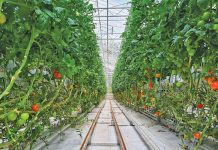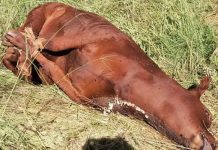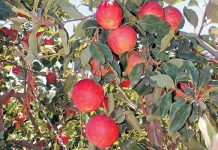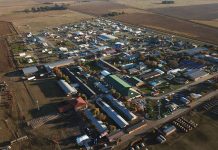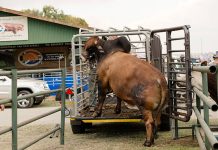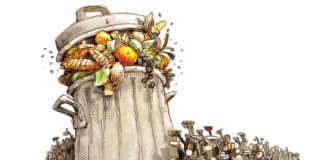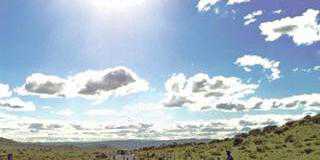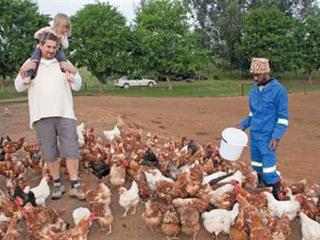
With the cost of poultry feed rising at an alarming rate, an inventive poultry producer in the KZN Midlands has opted to use homegrown fly grubs as an alternative protein source. If successful, his trial could show the despised fly in a different light.
“With escalating feed prices, we needed to find an alternative protein source,” says free-range poultry producer and processor Chris Slater from the Dargle Valley.
“We even bought a feed mixer to mix our own feed, but when soya bean prices went through the roof, this was no longer viable. We’d heard about grub farming and decided to try it on a small scale. Research has shown that grubs contain 55% protein.”
Slater breeds the grubs in plastic buckets, and the system is simplicity itself. There are 15 breeding sites, each consisting of two stacked buckets. Holes are drilled into the lid and base of the top bucket, which is then inserted firmly into the bottom one. Chicken litter a few centimetres deep is placed in the top bucket and this is topped with two handfuls of butchery waste. “We only use solid chicken waste from our butchery, and not waste such as blood and intestines from an abattoir,” Slater says.
Most flies go through four life stages: egg, larva (grub), pupa and adult fly. In warm weather, this life cycle takes between one and three weeks; in cooler conditions it can take two or three months. Flies – mostly houseflies – enter the lid of the top bucket and lay eggs in the butchery waste. These hatch into larvae, which then eat the offal. When they are ready to pupate, the grubs burrow through the chicken litter and fall through the holes into the bottom bucket – “clean, fat and juicy,” says Slater.
He currently produces 10kg of grubs every three days and these are fed live to the chickens. “We simply place the grubs in outside feeding troughs for the chickens to eat,” he explains. “They’re supplied in addition to the normal feed, which is usually placed in chicken feeders inside the house. At this stage we’re feeding grubs only to our layers, not the broilers, mostly due to limited quantities of grubs.”
Energy-rich feed
Slater has found that every 15kg of grubs saves 50kg of feed. “Chickens only eat what they need for their protein requirement, so if there’s another protein source such as grubs, they’ll eat less chicken feed. This enables us to reduce the chicken feed by more than the amount of grubs fed,” Slater says.

The Story of the Fly and How It Could Save the World is published by Jason Drew and Justine Joseph. For more details, go to www.thestoryof thefly.com
Although he has used the system for only a few weeks, Slater can already see ways of improving production. “With all the wet weather, we’ve had to put a roof over the buckets to keep them dry or the breeding process slows down too much – the eggs need sun and warmth to hatch,” he says. The next plan is to build or adapt a shed with fly-screen windows for the buckets.
“We’d then be able to breed our own flies,” he explains. “We‘d keep one bucket of grubs each cycle and allow them to mature into flies. This would keep the cycle going and we can hopefully produce more than 100kg a day.” Staff member Themba Msomi performs the day-to-day tasks associated with breeding grubs. He checks buckets daily after the first four to five days, and replaces offal every eight to 10 days. The old waste is burnt.
“We’re going to try mincing the old waste to see if the grubs will eat it and that will leave no waste whatsoever,” explains Slater. Although his project is still in an experimental phase, he is adamant that it has helped reduce his feed costs. “And the maggots cost us nothing to produce. We use 10kg buckets that we bought our marinade in, chicken litter from the houses, and chicken offal from the butchery,” he says.
Rapid reproduction
According to Jason Drew, co-founder of AgriProtein Technologies, a commercial fly farm and larvae production facility near Stellenbosch, a female housefly will lay up to 800 eggs in her lifetime. “Eggs are usually laid in warm organic material or waste. These eggs hatch into larvae, which take just a few days to increase over 400 times in weight,” he says in his new book, The Story of the Fly and How It Could Save the World.
Grubs need to be harvested before they pupate and form a hard capsule. ”This is when they contain the highest level of protein and digestibility. In nature, most birds won’t eat them after this because they can’t access the protein,” says Drew.
AgriProtein uses 100t of live grubs to produce 28t of ‘Magmeal’, dried larvae that is used as a natural alternative to fish meal and poultry feed.

These juicy grubs contain 55% protein.
“Fish and birds love to eat flies and larvae,” writes Drew in the book. “Chickens will naturally peck around in the dirt for them and fish will jump out of streams to grab them. Why? Because larvae are protein powerhouses. Nutritionally speaking, they are more natural and at least as good as fishmeal. And when it comes to soya, they are more sustainable and certainly more complete.”
Fly species need to be matched to specific waste. For example, the housefly and blowfly opt for abattoir waste, while the black soldier fly prefers to lay its eggs in carbohydrate- containing material such as manure and rotting vegetable matter. “In 2011 in Spain, 20 million black soldier larvae were processing a ton of zoo-animal waste a day,” explains Drew.
“That’s faster and more efficient than even the most energetic earthworms or any other band of compost creators. I’d encourage everyone to recycle and create larvae. One organism’s waste is another’s favourite food. That’s why, in the natural world, everything balances out and so little goes to waste. “It’s time to look a little closer at these alleged pests.”
Contact Chris Slater on [email protected] or Jason Drew on [email protected]

